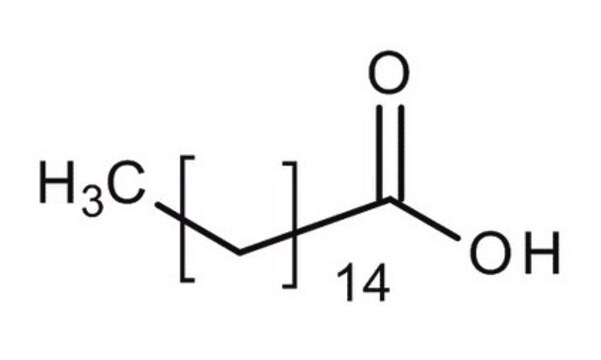Recommended Products
vapor pressure
10 mmHg ( 210 °C)
Assay
≥99%
form
powder
bp
271.5 °C/100 mmHg (lit.)
mp
61-62.5 °C (lit.)
density
0.852 g/mL at 25 °C (lit.)
functional group
carboxylic acid
lipid type
saturated FAs
shipped in
ambient
storage temp.
room temp
SMILES string
CCCCCCCCCCCCCCCC(O)=O
InChI
1S/C16H32O2/c1-2-3-4-5-6-7-8-9-10-11-12-13-14-15-16(17)18/h2-15H2,1H3,(H,17,18)
InChI key
IPCSVZSSVZVIGE-UHFFFAOYSA-N
Gene Information
human ... FABP2(2169) , FABP3(2170) , FABP4(2167) , FABP5(2171)
Looking for similar products? Visit Product Comparison Guide
Related Categories
General description
Application
- to study its effects on monocyte chemoattractant protein-1 (MCP-1) expression in adipocytes and THP-1 macrophages
- to stimulate lipotoxicity in primary rat hepatocytes
- in Et-bovine serum albumin (BSA) solution along with retinoic acid (RA) and retinol to study its effects on spermatogenesis or meiotic progression
Storage Class Code
11 - Combustible Solids
WGK
nwg
Flash Point(F)
235.4 °F
Flash Point(C)
113 °C
Personal Protective Equipment
Certificates of Analysis (COA)
Search for Certificates of Analysis (COA) by entering the products Lot/Batch Number. Lot and Batch Numbers can be found on a product’s label following the words ‘Lot’ or ‘Batch’.
Already Own This Product?
Documents related to the products that you have purchased in the past have been gathered in the Document Library for your convenience.
Difficulty Finding Your Product Or Lot/Batch Number?
How to Find the Product Number
Product numbers are combined with Pack Sizes/Quantity when displayed on the website (example: T1503-25G). Please make sure you enter ONLY the product number in the Product Number field (example: T1503).
Example:
Additional examples:
705578-5MG-PW
PL860-CGA/SHF-1EA
MMYOMAG-74K-13
1000309185
enter as 1.000309185)
Having trouble? Feel free to contact Technical Service for assistance.
How to Find a Lot/Batch Number for COA
Lot and Batch Numbers can be found on a product's label following the words 'Lot' or 'Batch'.
Aldrich Products
For a lot number such as TO09019TO, enter it as 09019TO (without the first two letters 'TO').
For a lot number with a filling-code such as 05427ES-021, enter it as 05427ES (without the filling-code '-021').
For a lot number with a filling-code such as STBB0728K9, enter it as STBB0728 without the filling-code 'K9'.
Not Finding What You Are Looking For?
In some cases, a COA may not be available online. If your search was unable to find the COA you can request one.
Articles
Fatty acids of the n-3, n-6 and n-9 families are important supplements for cell culture systems. They are important in cell culture systems used to biomanufacture heterologous proteins, such as monoclonal antibodies.
How palmitic acid, other fatty acids and other cell culture components affect the performance of serum-free, protein-free cell culture systems used for biomanufacturing heterologous proteins including monoclonal antibodies.
Our team of scientists has experience in all areas of research including Life Science, Material Science, Chemical Synthesis, Chromatography, Analytical and many others.
Contact Technical Service



